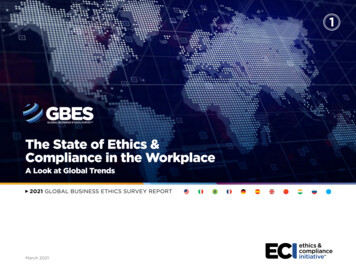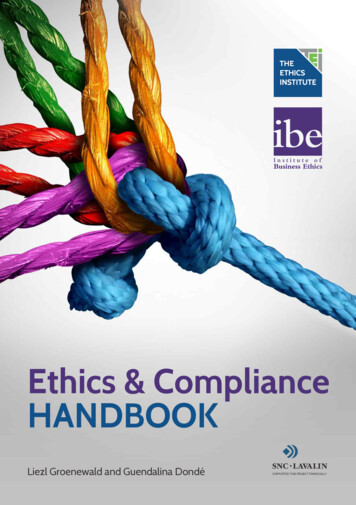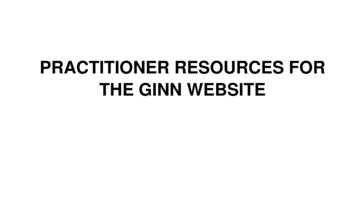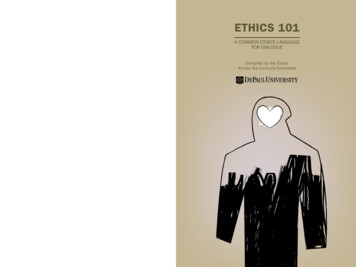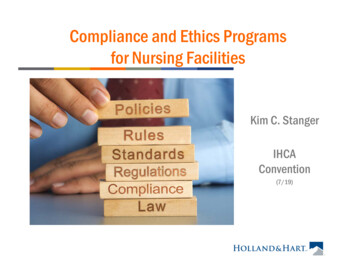
Transcription
Compliance and Ethics Programsfor Nursing FacilitiesKim C. StangerIHCAConvention(7/19)
This presentation is similar to any other legal educationmaterials designed to provide general information onpertinent legal topics. The statements made as part of thepresentation are provided for educational purposes only.They do not constitute legal advice nor do they necessarilyreflect the views of Holland & Hart LLP or any of itsattorneys other than the speaker. This presentation is notintended to create an attorney-client relationship betweenyou and Holland & Hart LLP. If you have specific questionsas to the application of law to your activities, you shouldseek the advice of your legal counsel.
Overview1. New COPs re Compliance & Ethics Programs2. Issues to address in the Program Please ask questions or comment as we go along 3
Written Materials.Ppt slidesCompliance and Ethics Program Rule, 42 CFR 483.85HHS commentary to Rule, 81 FR 68812OIG Compliance Program Guidance, 65 FR 14289OIG Supplemental Compliance Program Guidance forNursing Facilities, 73 FR 56832 CMS, Nursing Home Toolkit: Program Integrity and Quality ofCare—An Overview for Nursing Home Providers Available on IHCA website
Compliance and Ethics ProgramRequirements
History 1970’s and 1980’s: high profile corporate fraud or misconduct. 1991: DOJ sentencing guidelines factor compliance program. 2000: OIG Compliance Program Guidance for Nursing Facilities (65 FR14289)– Voluntary 2008: OIG Supplemental Compliance Program Guidance for NursingFacilities (73 FR 56832)– Voluntary 2010: Affordable Care Act 6102– Mandated compliance plans for nursing facilities 2015: Proposed rules for nursing facilities (80 FR 42217) 2016: Final rules for nursing facilities at 42 CFR 483.85 (81 FR 68812) 2017: Required compliance by November 28, 2019 (81 FR 68688) No interpretive guidelines yet
42 CFR 483.85 Beginning November 28, 2019, the operatingorganization for each facility must have in operation acompliance and ethics program for each facility.(42 CFR 483.85(b)) “Operating organization” means the individual(s) orentity that operates a facility.– Owner?– Manager?– Administrative services company?(42 CFR 483.85(a))
42 CFR 483.851. Prevent and detectcriminal, civil andadministrativeviolations.2. Promote quality ofcare per regulations.After November 28, 2019, surveyorsmay issue citations for failure to havethe required program (Ftag F895).
Compliance and Ethics Programs Must be designed, implemented and enforced to beeffective in:– preventing and detecting criminal, civil andadministrative violations, and– promoting quality care. Compliance program extends to:– Operating organization’s staff,– Contractors, and– Volunteers(42 CFR 483.85(a))
Compliance and Ethics Program Good reasons to have one– Facilitates compliance by identifying and responding toproblems early on.– Demonstrates commitment to integrity.– May mitigate penalties.– May improve performance. facilitates prompt claims submissionsidentifies undercoding as well as upcodingreduces claim denialsimproves medical record documentationmay identify and prevent resident care problems– Others?
Compliance Program ElementsAll operating organizations1. Written compliance program.2. Assign responsibility.3. Sufficient resources.4. Do not delegate improperly.5. Train personnel.6. Ensure compliance, e.g.,––Organizations with 5 facilities9. Annual training.10. Compliance officer.11. Compliance liaison at eachfacility.monitoring and auditingappropriate reporting process.7. Enforce program.8. Respond appropriately.* Annual review(42 CFR 483.85)
reliminary-toolkit.pdf
1. Written Standards, Policies andProcedures Must have written compliance and ethicsstandards, policies and procedures that:– Are reasonably capable of reducing criminal, civil andadministrative violations; and– Promote qualify of care.(42 CFR 483.85(c)(1)) Standards the rules. Policies and procedures how rules are to beachieved, addressed and enforced.
Written Standards, Policies and Procedures At a minimum, written policies must include:– Designation of appropriate compliance and ethics programcontact to whom individuals may report suspected violations;– Alternative method to report anonymously without fear ofretribution; and– Disciplinary standards that set out consequences forviolations for: Operating entity’s entire staff, Individuals providing services under contract, and Volunteers, consistent with their expected roles.(42 CFR 483.85(c)(1))
Written Standards, Policies and Procedures Consider– Coordinate standards, policies and procedures with: Mission and values statement Employee handbook Contracts Other key employee documents– Consider consolidating basic rules in a Code of Conduct. More easily understood by staff and others Separate from policies and procedures– Others?
2. Assign Compliance Responsibilityto High-Level Person Assign to “high-level personnel” the responsibility tooversee compliance with program’s standards, policiesand procedures.(42 CFR 483.85(c)(2)) “High-level personnel” individual(s) who havesubstantial control over the operating organization orwho have a substantial role in making policy, e.g.,– CEO,– Board members, or– Directors of major divisions.(42 CFR 483.85(a))
Assign Compliance Responsibilityto High-Level Person Consider– “Oversight” is not the same as making the person theeffective compliance officer. “Buck stops here”– Include compliance in job description or contract andcompliance program documents.– Coordinate responsibilities with HIPAA privacy/securityofficer.– Others?
3. Sufficient Resources Dedicate sufficient resources and authority to thespecific individuals assigned to compliance toreasonably assure compliance with the standards,policies and procedures.(42 CFR 483.85(c)(3))
Sufficient Resources Consider– Resources depend on circumstances, e.g., size offacility, number of facilities, etc.– Use facility assessment required by 42 CFR 483.70(e),i.e., specific line item re compliance.– Identify personnel. Ensure they understand compliance is part of their job Ensure others know of their authority– Establish budget.– Others?
4. Appropriate Delegation Due care not to delegate substantial discretionaryauthority to individuals who the operatingorganization knew, or should have known throughthe exercise of due diligence, had a propensity toengage in criminal, civil, and administrativeviolations under the Social Security Act.(42 CFR 483.85(c)(4))
Appropriate Delegation Consider– Conduct and document background checks.– Check exclusion lists. List of Excluded Individuals and Entities (“LEIE”),https://exclusions.oig.hhs.gov/ System for Award jsf State Medicaid sites.– Others?
5. Train Personnel Take steps to effectively communicate the standards,policies, and procedures to:– Entire staff of the operating organization;– Individuals providing services under a contractualarrangement; and– Volunteers, consistent with the volunteers' expected roles. Must include, but is not limited to:– Mandatory participation in training as set forth at§483.95(f), or– Orientation programs, or– Disseminating info that explains in a practical manner whatis required under the program.(42 CFR 483.85(c)(5))
Train Personnel A facility must develop, implement, and maintainan effective training program for:– All new and existing staff;– Individuals providing services under a contractualarrangement; and– Volunteers, consistent with their expected roles. Among other things, training must explain therequirements of the compliance program.(42 CFR 483.95(f))
Train Personnel Consider– Require personnel to participate in training programs.– Copies to vendors/contractors as part of the contractingprocess and annually thereafter.– Post compliance plan or code of conduct on intranet andinternet.– Require that employees and others sign annual attestationsthat they have received and read and understand the codeof conduct and/or compliance program.– Have employees, agents and volunteers sign in whenevercompliance topics are discussed at meetings.
Train Personnel Consider– If you use electronic learning platforms, have a copy ofcompliance modules available for the survey team.– Track participation in compliance programs.– Discipline those who fail to participate.– Assign someone the task of conducting complianceinterviews with staff, agents and volunteers on arandom yet regular basis. Ask questions like: Do you know if this facility has a compliance program? What are you supposed to do if you have concerns? To whom should you report concerns?
6. Steps to Achieve Compliance Take reasonable steps to achieve compliance withthe program, including but not limited to:– Monitoring and auditing systems reasonably designedto detect criminal, civil, and administrative violations;– Having and publicizing a reporting system wherebyindividuals may report violations anonymously andwithout fear of retribution; and– Having a process to ensure the integrity of reporteddata.(42 CFR 483.85(c)(6))
Steps to Achieve Compliance Consider– Start with self-assessment or gap analysis to identifycompliance risk areas. Recent surveys and internal reports Regulatory standards OIG Compliance Program Guidance for Nursing Facilities, 65FR 14289 (2000) OIG Supplemental Compliance Program Guidance for NursingFacilities, 73 FR 56832 (2008)– Establish compliance work plan to address identifieddeficiencies.– Follow up!
Steps to Achieve Compliance Auditing and monitoring– Incorporate auditing and monitoring. Auditing: systematic review.–Proactive–Reactive Monitoring: watch to ensure systems are working.– Involve attorney to maximize attorney-client privilege orwork-product doctrine.– Others?
Steps to Achieve Compliance Auditing and monitoring– CMS expects periodic audits focusing on: Financial records Quality of care issues– ACA Report and Repay rule requires repayment within60 days. Contemplates ongoing auditing or monitoring. Knew or should have known standard.– Coordinate with Quality Assurance PerformanceImprovement (“QAPI”) programs.
Steps to Achieve Compliance Effective reporting system– Designate compliance officer or liaison.– Establish compliance hotline, e.g., 1-800 number.– Ensure reporting process is well-publicized, e.g.,training, handbook, posters, internet, intranet, website,newsletters, admission packets, etc.– Publish strong no-retaliation policy.– Respond promptly to compliance concerns that areraised.– Maintain a log of complaints and timely responses.
7. Enforcement Consistent enforcement of the standards, policies,and procedures through appropriate disciplinarymechanisms, including:– Discipline of those who violate program standards orpolicies; and– Discipline of those responsible for the failure to: Detect a violation, and Report a violation.(42 CFR 485.85(c)(7))
Enforcement Consider– Confirm discipline for compliance violations, up to andincluding termination.– Confirm obligation to report violations.– Coordinate compliance program with employeehandbook, policies, contracts, etc.– Include acknowledgement of discipline in annualemployee attestation.– Ensure discipline is applied fairly and consistently.
8. Respond to Violations After a violation is detected, the operatingorganization must ensure that all reasonable stepsidentified in its program are taken to respondappropriately to the violation and to prevent furthersimilar violations, including any necessarymodification to the operating organization'sprogram.(42 CFR 483.85(c)(8))
Respond to Violations Consider– Ensure program documents require prompt action toaddress and correct noncompliance.– Compliance officer or designee coordinate any investigation,conclusions, and recommended corrective action.– Program should require all persons to cooperate ininvestigation.– Discipline as necessary.– Confirm obligation to report and repay, address violation ofprogram, and modify policies or processes to avoid repeats.
Additional Requirements forOperators with 5 or More Facilities Smaller organizations may want to implement if able
9. Annual Training Conduct mandatory annual training program on thecompliance and ethics program that meets therequirements set forth in §483.95(f).(42 CFR 483.85(d)(1)) No specific direction concerning content, but likelyshould address:– Compliance program components.– Common or ongoing compliance issues.– Policies or procedures to address concerns.
10. Compliance Officer Designate a compliance officer for whom theoperating organization's compliance and ethicsprogram is a major responsibility. Compliance officer must:– Report directly to the operating organization'sgoverning body, and– Not be subordinate to the general counsel, chieffinancial officer or chief operating officer.(42 CFR 483.85(d)(2))
Compliance Officer Consider– Conflicts of interest in appointing compliance officer, e.g., If compliance officer is also director of accounting. If compliance officer is related to other high-level officer inoperating organization.(80 FR 42220)– Appropriate skills Good communication and collaboration.Understands organization’s operations.Objective and independent.Others?
11. Compliance Liaison Designate a compliance liaison located at each ofthe operating organization's facilities.(42 CFR 483.85(d)(3)) Liaisons assist the compliance officer at eachfacility. Each organization has flexibility to determine thequalifications, duties and responsibilities for theliaisons.(81 FR 68816)
Bonus forall facilitiesAnnual Review Operating organization for each facility must:– Review its compliance and ethics program annually, and– Revise its program as needed to reflect changes in allapplicable laws or regulations and within the operatingorganization and its facilities to improve its performancein deterring, reducing, and detecting violations underthe Act and in promoting quality of care.(42 CFR 483.85(e)) Document annual review.
Issues to Address
Issues to Address SNFs and NFs must comply with:– All applicable Federal, State, and local laws and regulations, andcodes, and– Accepted professional standards and principles applicable toservices in facilities. Specifically, facilities must comply with:– 42 CFR part 483;– Nondiscrimination on the basis of age, sex, race, color, nationalorigin, or disability (45 CFR parts 45, 80, 84, 91, 92);– Protection of human subjects of research (45 CFR part 46);– Fraud and abuse (42 CFR part 455); and– Protection of individually identifiable health information (45 CFRparts 160 and 164).(42 CFR 483.70(b)-(c))
ance/index.asp
OIG Compliance ProgramGuidance for Nursing HomesOIG Compliance Guidance (2000) Quality of care Residents’ rights Employee screening Vendor relationships Billing and cost reporting Record keeping anddocumentationOIG Supplemental Guidance (2008) Quality of care Submission of accurate claims Anti-Kickback Statute Physician Self-Referrals(“Stark”) Anti-supplementation HIPAA and Security Rules(65 FR 14292)(73 FR 56833)
Quality of Care
Quality of Care OIG recommends:– Statement that affirms commitment to high quality care.– Continually measure performance against applicablestandards, including Medicare requirements.– Quality of care protocols.– Review resident outcomes and improve on outcomes.– Use current and past surveys to improve.– Assess vulnerabilities and risk areas.(OIG Compliance Guidance (2000))
Quality of Care Risk areas– No accurate assessment of resident’s functional capacity orcomprehensive care plan.– Inappropriate or insufficient treatment and services toaddress resident’s clinical conditions, including Pressure ulcers Dehydration Malnutrition Incontinence Mental or psychosocial problems(OIG Compliance Guidance (2000); OIG Supplemental Guidance (2008))
Quality of Care Risk areas– Failure to accommodate individual resident needs andpreferences.– Inadequate medication management.– Inappropriate use of psychotropic medications.– Inadequate staffing levels or insufficiently trained orsupervised staff.– Failure to provide appropriate therapy services.(OIG Compliance Guidance (2000); OIG Supplemental Guidance (2008))
Quality of Care Risk areas– Failure to provide appropriate services to assistresidents with activities of daily living.– Failure to provide an ongoing activities program to meetindividual needs.– Patient safety, including Failure to report incidents of abuse or neglect Failure to protect from other residents. Failure to screen staff.(OIG Compliance Guidance (2000); OIG Supplemental Guidance (2008))
Resident Rights
Residents Rights Policies should address rights specified in:– Federal laws and regulations 42 CFR part 483, including 483.10, 483.12, 483.15, etc. Others?– State laws and regulations IDAPA 16.03.02 Others?– Admission agreements?– Others?
Residents Rights Rights include, but are not limited to:– Treated with dignity and respect.– Manage his/her own money or choose someone to manageit.– Use his/her own belongings so long as it does not affectothers and space and safety permit.– Privacy and confidentiality.– Informed about services, patient condition and medication.– Refuse medications and treatments.– Participate in decisions and care planning.– Make independent choices, including re a physician.(CMS, Nursing Home Toolkit: Program Integrity and Quality of Care)
Residents Rights Risk areas– Discriminatory admission or improper denial of access tocare.– Verbal, mental or physical abuse, corporeal punishment,and involuntary seclusion.– Inappropriate use of physical or chemical restraints.– Failure to ensure that residents have personal privacy andaccess to their personal records.– Denial of right to participate in care or treatment.– Failure to safeguard resident’s financial affairs.(OIG Compliance Guidance (2000))
Fraud and Abuse“I want mymoneyback!” False Claims Act Anti-Kickback Statute(“AKS”) Ethics in Physician ReferralsAct (“Stark”) Civil Monetary Penalties Law(“CMPL”) Eliminating Kickbacks inRecovery Act (“EKRA”) Travel Act Idaho False Claims Act Idaho Anti-Kickback Statute
Increased PenaltiesFalse Claims ActOld PenaltyNew Penalty 5,500 to 11,000 /claim 10,781 to 21,563 /claim Failure to repayAnti-Kickback Statute 20,000 per claim 25,000 criminal penalty5 years in prison 100,000 criminal penalty10 years in prison 50,000 100,000 civil penaltyEthics in Patient Referrals(“Stark”) 15,000 per claim 24,748 per claim Circumvention scheme 100,000 164,992Civil Monetary Penalties Law 20,000 to 100,000 Induce beneficiaries 10,000 20,000 Excluded individual 10,000 20,000(See 45 CFR 102.3)
False Claims Act Cannot knowingly submit a false claim for payment tothe federal government. Must report and repay an overpayment within the laterof 60 days after overpayment identified or datecorresponding cost report is due. Penalties–––––Repayment plus interestCivil monetary penalties of 11,000 to 22,000* per claim3x damagesExclusion from Medicare/MedicaidQui tam lawsuits(31 USC 3729; 42 CFR 102.3; see also 18 USC 1347)
Idaho False Claims Act Cannot knowingly:––––––Submit claim that is incorrect.Make false statement in any document to state.Submit a claim for medically unnecessary service.Fail repeatedly or substantially to comply with DHW rules.Breach provider agreement.Fail to repay amounts improperly received. Penalties– Exclusion from state health programs, e.g., Medicaid.– Civil penalty of up to 1000 per violation.– Referral to Medicaid fraud unit.(IC 56-209h(6))
Fraud and Abuse Risk areas––––––––Billing for items or services not provided as claimed.Claims for medically unnecessary services or supplies.Claims to Part A for residents who are not eligible.Duplicate billing.Failing to identify and refund credit balances.Claims for items or services not ordered.Billing for inadequate or substandard care.Misleading info about resident’s medical condition affectingreimbursement.(OIG Compliance Guidance (2000); OIG Supplemental Guidance (2008))
Fraud and Abuse Risk areas– Upcoding.– Unbundling.– Billing residents for items in the per diem rate or that areotherwise covered by third-party payers.– Altering documentation or forging physician signaturesto verify orders or services provided.– Insufficient documentation to support services.– False cost reports.(OIG Compliance Guidance (2000))
Anti-Kickback Statute Cannot knowingly and willfully offer, pay, solicit orreceive remuneration to induce referrals for items orservices covered by government program unlesstransaction fits within a regulatory safe harbor.(42 USC 1320a-7b(b)) “One purpose test”– Anti-Kickback Statute applies if one purpose of theremuneration is to induce referrals. (U.S. v.Greber, 760F.2d 68 (3d Cir. 1985)).– Difficult to disprove. Ignorance of the law is no excuse.
Anti-Kickback Statute Penalties– 10 years in prison– 100,000 criminal fine– 100,000 penalty– 3x damages– Exclusion fromMedicare/Medicaid Anti-Kickback violation False Claims Act violation(42 USC 1320a-7b(b); 42 CFR102.3) OIG Self-DisclosureProtocol: minimum 50,000 settlement.– Lower standard of proof– Subject to False ClaimsAct penalties– Subject to qui tam suit.(42 USC 1320a-7a(a)(7))
Idaho Anti-Kickback Statute Service provider (including providers of healthcareservices) cannot:– Pay another person, or other person cannot acceptpayment, for a referral.– Provide services knowing the claimant was referred inexchange for payment.– Engage in regular practice of waiving, rebating, giving orpaying claimant’s deductible for health insurance. Penalties– 5000 fine by Dept of Insurance(IC 41-348)
Anti-Kickback Statute Risk areas– Free or discounted goods or services. Giving or receiving to induce referrals. Beware hospices.– Services contracts with referring providers, medical directors. Above fair market value. Compensation varies based on referrals. Contract for unnecessary services.– Waiver of copays or cost-sharing absent financial need.– Reserved bed payments.– Anything else of value that induces referrals.(OIG Compliance Guidance (2000); OIG Supplemental Guidance (2008))
Anti-Supplementation Must accept applicable Medicare/Medicaidpayment (including copays) as complete paymentfor covered items and services. Cannot charge anyone (e.g., beneficiary, third party)any additional amount. Penalties– Violation of Medicare participation agreement.– Criminal penalties(42 USC 1395cc(a) and 1320a-7b(d); 42 CFFR 489.20, -489.15, and483.12(d)(3); see also OIG Supplemental Guidance (2008))
Eliminating Kickbacks in Recovery Act(“EKRA”) Cannot solicit, receive, pay or offer anyremuneration in return for referring a patient to alaboratory, recovery homes or clinical treatmentfacility unless arrangement fits within regulatoryexception. Penalties– 200,000 criminal fine– 10 years in prison(18 USC 220)
Ethics in Patient Referrals Act(“Stark”) If a physician (or their family member) has afinancial relationship with an entity:– The physician may not refer patients to that entityfor designated health services, and– The entity may not bill Medicare or Medicaid forsuch designated health services (“DHS”)unless arrangement structured to fit within aregulatory exception.(42 CFR 411.353)
Stark Penalties– No payment for services provided per improper referral.– Repayment of payments improperly received within 60days.– Civil penalties. 24,748 per claim submitted 164,922 per circumvention scheme(42 CFR 411.353, 1001.102(a)(5); 1001.103(b); and 102.3) May also constitute Anti-Kickback Statute violation May trigger False Claims Act.
Stark Applies to referrals for designated health services (“DHS”)payable in whole or part by Medicare.––––––––––Inpatient and outpatient hospital servicesOutpatient prescription drugsClinical laboratory servicesPhysical, occupational, or speech therapyHome health servicesRadiology and certain imaging servicesRadiation therapy and suppliesDurable medical equipment and suppliesParenteral and enteral nutrients, equipment, and suppliesProsthetics and orthotics Not services reimbursed by Medicare as part of composite rate (forexample, SNF Part A payments, except if listed items are themselvespayable through a composite rate (e.g., home health services orinpatient and outpatient hospital services).(42 CFR 411.351)
Idaho Stark Law(kind of) Idaho Medicaid regulations allow DHW to “denypayment for any and all claims it determines are foritems or services provided as a result of aprohibited physician referral under [Stark,] 42 CFRPart 411, Subpart J.”(IDAPA 16.05.07.200.01) Not clear if this would create affirmative obligationto report and repay amounts received in violation ofStark.
Civil Monetary Penalties LawProhibits certain specified conduct, e.g.: Submitting false or fraudulent claims, misrepresenting facts relevantto services, or engaging in other fraudulent practices. Violating Anti-Kickback Statute or Stark law. Violating EMTALA. Failing to report and repay an overpayment. Failing to grant timely access. Misusing “HHS”, “CMS”, “Medicare”, “Medicaid”, etc. Failing to report adverse action against providers. Offering inducements to physicians to limit services. Offering inducements to program beneficiaries. Submitting claims for services ordered by, or contracting with, anexcluded entity.(42 USC 1320a-7a; 42 CFR 1003.200-1100)
Inducements to Govt Program Patients Cannot offer or transfer remuneration to federal programbeneficiaries if you know or should know that theremuneration is likely to influence the beneficiaries toorder or receive items or services payable by federal orstate programs from a particular provider. Penalty:– 20,000 for each item or service. Also a likely– 3x amount claimed.violation of the– Repayment of amounts paid.Anti-Kickback– Exclusion from Medicare and Medicaid.Statute(42 USC 1320a-7a(a)(5); 42 CFR 1003 and 102.3)
Excluded Entities Cannot submit claim for item or service ordered orfurnished by an excluded person. Cannot hire or contract with an excluded entity or arrangefor excluded entity to provide items or services payable byfederal programs. Penalties–––– 10,000 per item or service.3x amount claimed.Repayment of amounts paid.Exclusion from Medicare and Medicaid(42 USC 1320a-7a(a)(8); 42 CFR 1003.200; OIG Bulletin, Effect of Exclusion)
https://exclusions.oig.hhs.gov/
Employee Screening Conduct appropriate background and reference checksbefore hiring.––––Appropriate licensing boards.Require certification of no convictions or exclusion.Ensure temp agencies perform background checks.Check the LEIE Require employees to report adverse action. Suspend employees upon credible allegations pendinginvestigation. Prohibit continued employment if:– Criminal convictions.– Federal program exclusion.(OIG Compliance Guidance (2000); OIG Supplemental Guidance (2008))
Creation and Retention of Records
Creation and Retention of Records Policies should address:– Accurate, complete and timely creation of records.– Retention of records.– Destruction of records when appropriate. Policies extend to:––––Resident care records.Records and document necessary to support claims.Auditing and monitoring results.Compliance program documents, including communications withMedicare or other agencies. Comply with security rule.(OIG Compliance Program Guidance (2000))
Resident Privacy Resident rights HIPAA– Privacy– Security– Breach Notification
Civil Penalties(45 CFR 160.404; 42 CFR 102.3)ConductPenaltyDid not know andshould not haveknown of violation 114 to 57,051 per violation Up to 28,525 per type per yearViolation due toreasonable cause 1,141 to 57,051 per violation Up to 114,102 per type per yearWillful neglect,but correct w/in 30days 11,182 to 57,051 per violation Up to 285,255 per type per yearWillful neglect,but do not correctw/in 30 days At least 57,051 per violation Up to 1,711,533 per type per year No penalty ifcorrect w/30 days. OCR may waive orreduce penalty. Penalty ismandatory.
Criminal Penalties(42 USC 1320d-6(a)) Applies if employees or other individuals obtain ordisclose protected health info (“PHI”) from coveredentity without authorization.ConductPenaltyKnowingly obtain info in violation of thelaw 50,000 fine 1 year in prisonCommitted under false pretenses 100,000 fine 5 years in prisonIntent to sell, transfer, or use forcommercial gain, personal gain, ormalicious harm 250,000 fine 10 years in prison
HIPAA PrivacyConfidentiality Don’t access, use or discloseprotected health info (“PHI”)unless:– Treatment, payment orhealthcare operations– Families or others involved incare no objection– Govt function or public safetyexceptions– Resident request orAuthorization to disclose Minimum necessary rule Personal rep resident(45 CFR 164.500-.530)Resident Rights Notice of privacy practices Alternative means ofcommunication Access to info Amend info Accounting of disclosuresAdministrative Privacy and security officer Reasonable safeguards Training and sanctions Respond and mitigate
HIPAA Security Conduct and update securityrisk assessment Implement safeguards– Administrative– Technical– Physical Execute business associateagreements(45 CFR 164.300-.314)Beware Cybersecurity, especially– Phishing– Ransomware Social media, photos, etc. Unencrypted devices– Mobile devices (e.g., phones,tablets, etc.)– USB or other media Unencrypted e-mails, texts,photos
HIPAA Breach No
2008: OIG Supplemental Compliance Program Guidance for Nursing Facilities (73 FR 56832) -Voluntary 2010: Affordable Care Act 6102 -Mandated compliance plans for nursing facilities 2015: Proposed rules for nursing facilities (80 FR 42217) 2016: Final rules for nursing facilities at 42 CFR 483.85 (81 FR 68812)

